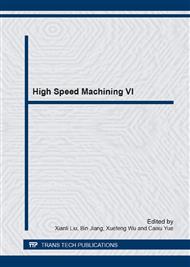p.311
p.316
p.321
p.327
p.332
p.337
p.342
p.348
p.353
Analysis of Microscopic Damage of Hardened Steel Milling Surface on Mould Service Process
Abstract:
The service performance is seriously effected by milling machined surface integrity of auto hardened steel mould. Basing on the microscopic damage evolution theory and hardened steel mould material micro-voids cell model, according to the service process load condition of hardened steel milling machined surface, surface microscopic damage evolution analysis had been conducted, surface evolution characteristics was obtained under different shapes void cell. Through comparative analysis the change law of damage evolution internal variable under different shapes void cell can know: respect to the ideal spherical, when the change of void volume fraction and the degree of matrix material yield were considered, the oblate hole more faster and the prolate hole more slower, which provide a further prediction for surface damage.
Info:
Periodical:
Pages:
332-336
Citation:
Online since:
July 2014
Authors:
Keywords:
Price:
Сopyright:
© 2014 Trans Tech Publications Ltd. All Rights Reserved
Share:
Citation:


